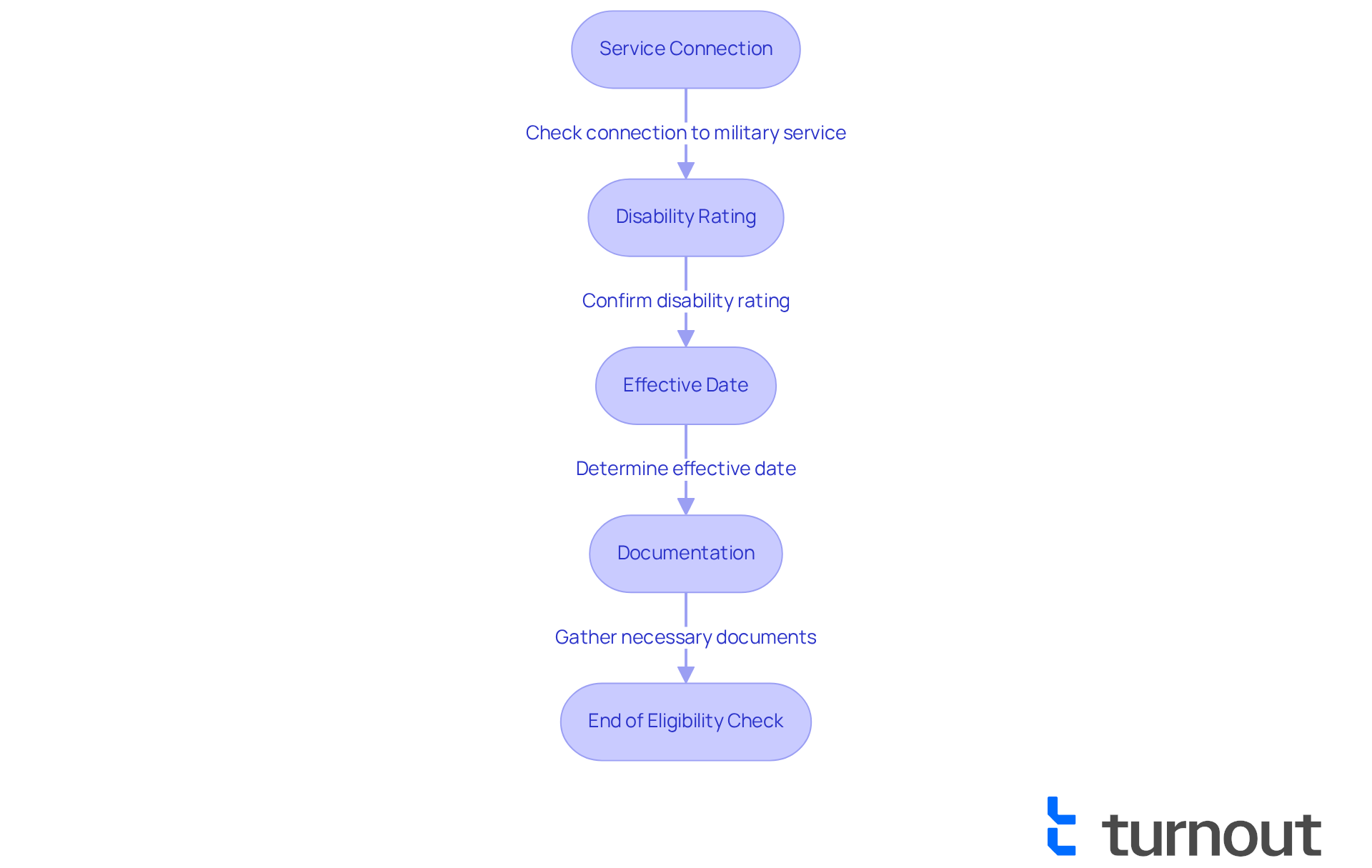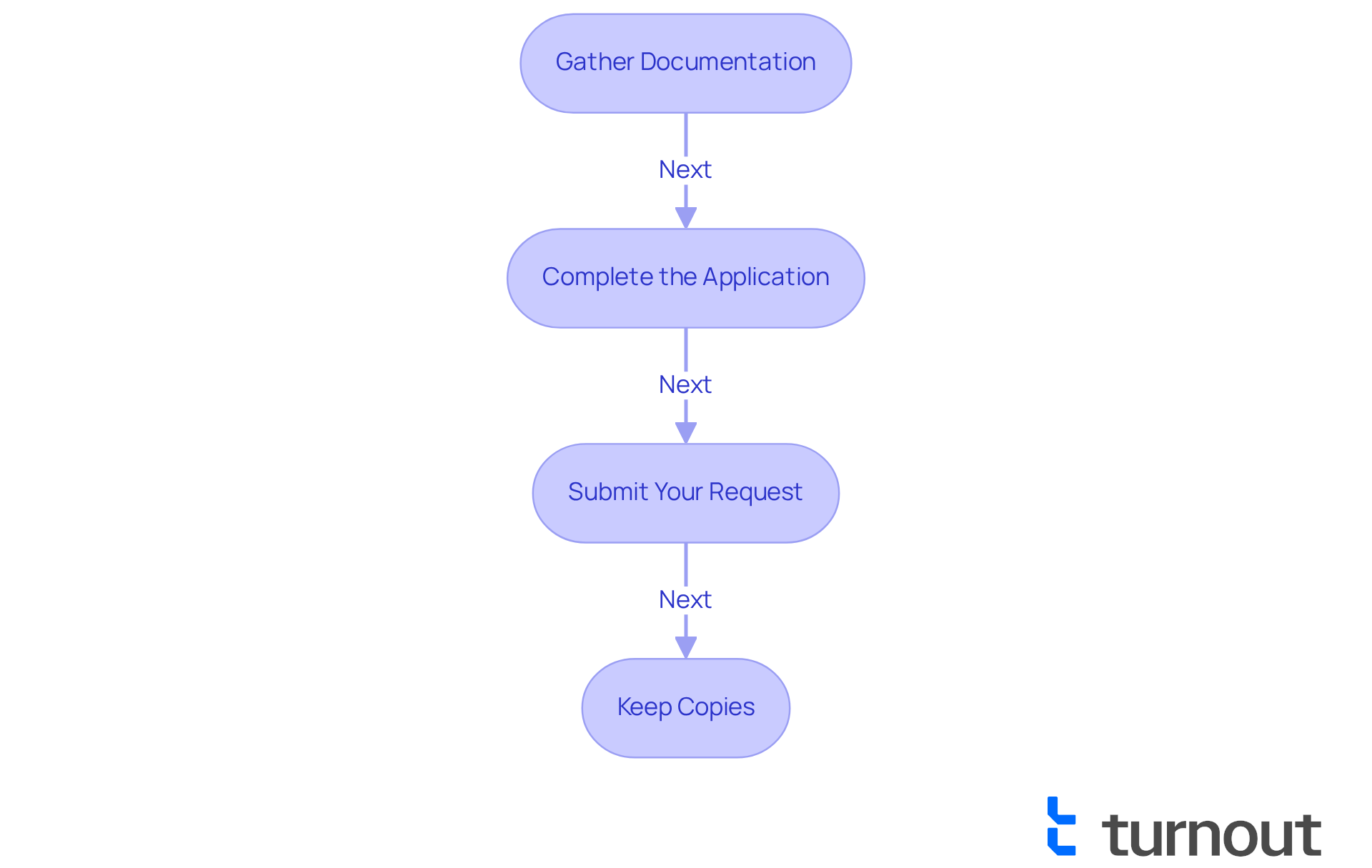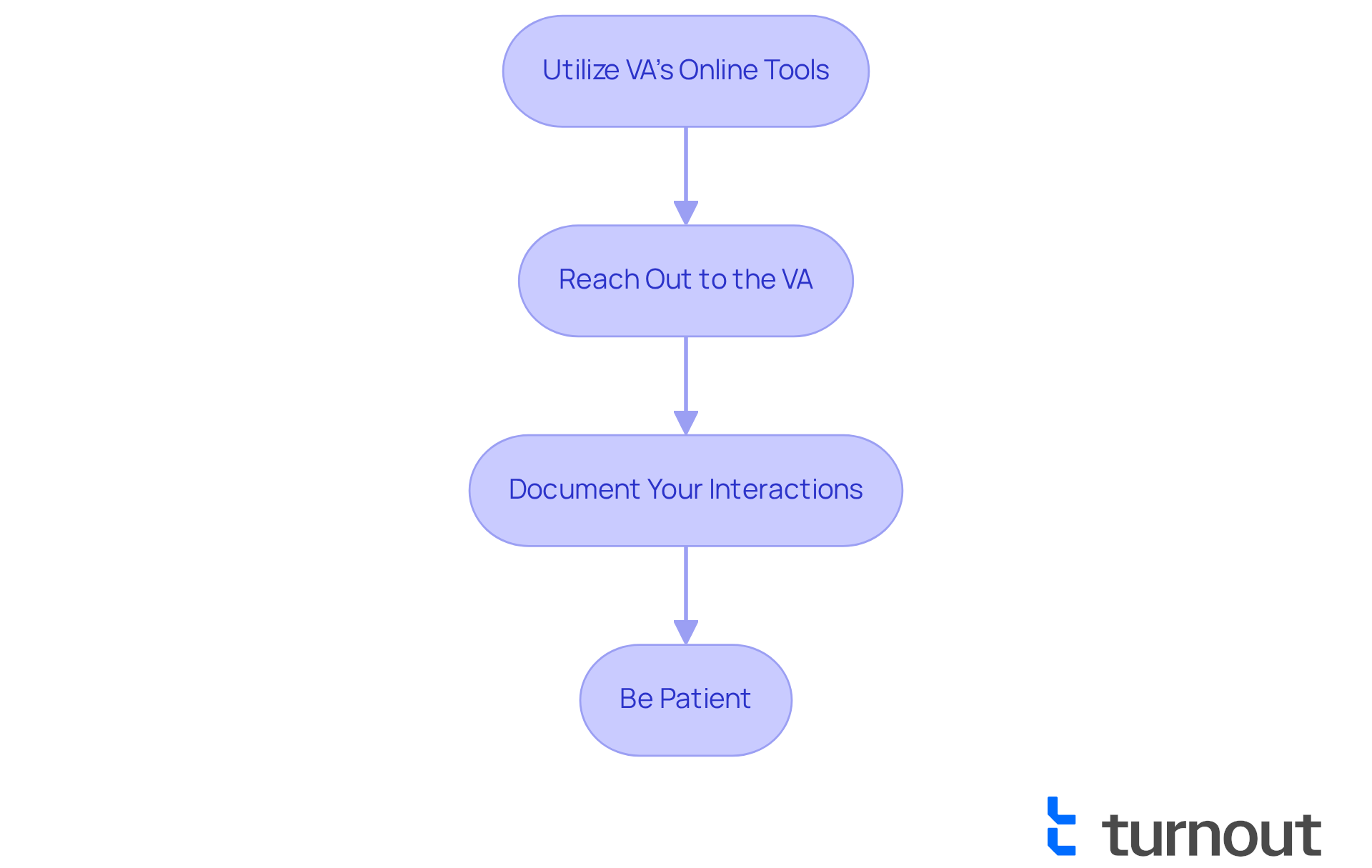Overview
This article gently guides you through the step-by-step process of mastering the VA back pay application. We understand that navigating this system can be overwhelming, and it's crucial to know the eligibility criteria, how to prepare your claim, submit it effectively, follow up, and handle any denials that may arise. Our goal is to ensure you feel informed and supported every step of the way.
You'll find detailed guidance on the necessary documentation and forms, along with strategies you can employ to simplify the complexities of the VA system. Remember, you are not alone in this journey; we’re here to help you understand what you need to do to achieve the support you deserve.
As you embark on this process, take a moment to reflect on your own experiences. It's common to feel uncertain or anxious, but with the right information and support, you can navigate this path with confidence. Let us walk alongside you, providing the insights you need to make informed decisions.
By following this guide, you can take proactive steps toward securing your benefits. Together, we can work through the challenges and ensure that you receive the assistance you’ve earned.
Introduction
Navigating the complexities of VA back pay can feel overwhelming for many veterans seeking the benefits they rightfully deserve. We understand that:
- Understanding the eligibility criteria
- Preparing the necessary documentation
- Mastering the submission process
are crucial steps in securing the largest possible compensation. However, it’s common to feel anxious about what happens when claims are denied or delays occur.
This guide offers a comprehensive, step-by-step approach to demystifying the VA back pay process. Our aim is to empower you to take control of your claims and ensure you are equipped to overcome any challenges along the way.
Remember, you are not alone in this journey; we're here to help.
Understand Eligibility for VA Back Pay
To qualify for VA retroactive payment, it’s important to understand the specific eligibility criteria that can help you in this process. Here’s how you can determine your eligibility:
-
Service Connection: Your disability must be linked to your military service. This includes injuries sustained during active duty or conditions that developed as a result of your service. We understand that this connection can sometimes be complex, but it is essential for your claim.
-
Disability Rating: Confirm your disability rating from the VA. A minimum rating of 0% is necessary to qualify for retroactive payments. However, if you have a single, permanent disability rated as 100% disabling, you may be eligible for significant benefits, including the largest VA back pay. It’s worth checking your rating closely.
-
Effective Date: Understand the effective date of your request. This is typically the date you submitted your application or when your condition deteriorated. Knowing this date is crucial for your claim.
-
Documentation: Collect essential documents, such as your DD Form 214, medical records, and any prior correspondence with the VA. Having these documents ready can ease your journey.
Real-life examples illustrate the importance of these criteria. For instance, veterans who require assistance with daily activities due to severe health limitations can also be eligible for increased compensation based on their need for Aid and Attendance. To qualify for Aid and Attendance, you must submit VA Form 21-2680, which assesses your need for assistance. Remember, you’re not alone in navigating this process.
Statistics indicate that a significant percentage of veterans qualify for VA compensation, especially those who have served a minimum of 90 days on active duty prior to September 8, 1980, or 24 months following that date with wartime service. By verifying your eligibility through these steps, you can pursue your request for VA compensation with assurance. We’re here to help you every step of the way.

Prepare and Submit Your VA Back Pay Claim
Once you’ve confirmed your eligibility, we understand that preparing and submitting your claim for the largest VA back pay can feel overwhelming. Follow these supportive steps to help guide you through the process:
-
Gather Documentation: Start by collecting all necessary documents, such as your service records, medical evidence, and any past requests. If you have a presumptive condition resulting from a change in regulation, please ensure you provide the necessary medical and military documents to substantiate your request. Remember, thorough documentation is key to a successful claim.
-
Complete the Application: Next, fill out the VA Form 21-526EZ, which is the application for disability compensation and related benefits. It’s important to complete all sections accurately to avoid any delays in processing. You might consider utilizing the Fully Developed Claims program, which allows you to submit all evidence at once for quicker resolutions regarding your request.
-
Submit Your Request: You can submit your request online through the VA’s eBenefits portal, by mail, or in person at your local VA office. Choose the method that feels most convenient for you, keeping in mind that online submissions may expedite the process.
-
Keep Copies: Always retain copies of your submitted request and any supporting documents for your records. This will be helpful if you need to reference your submission later. Additionally, you can provide lay evidence, which is written testimony from you or someone familiar with your condition, to bolster your request.
By following these steps, you can feel confident that your request is submitted accurately and efficiently. In 2025, the typical processing duration for VA compensation requests has improved, with requests being handled in around 131.8 days, reduced from 141.5 days earlier in the year. As VA Secretary Doug Collins stated, "We’re focused on getting results for Veterans," highlighting the importance of thorough preparation and accurate documentation. Remember, you are not alone in this journey, and we’re here to help you every step of the way.

Follow Up on Your VA Back Pay Claim Status
After submitting your request, we understand that following up to check its status is essential. Here’s how you can effectively monitor your VA back pay claim:
- Utilize the VA’s Online Tools: Access the VA’s eBenefits portal to verify the status of your application. This tool offers real-time updates on your request's progress, helping you stay informed. Remember, you need to create an account to access this feature.
- Reach out to the VA: For a more personal touch, consider calling the VA’s toll-free number or visiting your local VA office to inquire about your request's status. Engaging directly can sometimes yield quicker answers.
- Document Your Interactions: Keeping a detailed record of any communications with the VA, including dates, times, and the names of representatives you speak with, can be invaluable if issues arise.
- Be Patient: Processing durations can differ greatly, and it might take several weeks or even months for your request to be assessed. Understanding this can help manage your expectations.
By proactively checking in, you can ensure that you stay updated and can tackle any possible problems that might occur during the handling of your request. Notably, statistics indicate that 80% of veterans may be underrated by the VA, underscoring the importance of persistence in navigating the largest VA back pay system. Advocates stress that remaining proactive in monitoring your status can significantly impact your overall experience. As Eric Gang observes, 'Following up on your assertion is essential; it can greatly influence the outcome.

Navigate Denials and Appeals for VA Back Pay
If your claim for the largest VA back pay is denied, please don’t lose hope. We understand that this can be a challenging time, and we’re here to help you navigate the appeals process with care and support.
- Review the Denial Letter: Start by carefully reading the denial letter. Understanding the reasons for the decision is vital, as this will guide your request for reconsideration.
- Gather Additional Evidence: Next, collect any new evidence or documentation that supports your assertion. This may include updated medical records or statements from healthcare providers. For example, if you are a veteran with a 10% rating for diabetic neuropathy, submitting updated reports from a neurologist can strengthen your case for a higher rating. Presenting new medical evidence that was not included in the initial submission can greatly enhance your request.
- File a Notice of Disagreement (NOD): Remember to submit an NOD to the VA within one year of the denial. This document conveys your opposition to the decision and initiates the review process. It’s important to keep in mind that approximately 30% of initial VA claims are denied, making this step crucial.
- Consider Representation: While not mandatory, you may find it beneficial to seek support from a skilled representative. Many veterans report that having assistance increases their chances of success, especially since nearly 40% of cases heard by the Board of Veterans’ Appeals result in favorable decisions.
- Remain Tenacious: The process for requesting a review can be lengthy, but your determination is essential. Monitor deadlines closely and check in consistently on the progress of your request. Veterans have one year to submit a request for reconsideration after receiving a rating decision, so taking prompt action is crucial.
Furthermore, it’s important to understand the three primary options for challenges: Higher-Level Review, Supplemental Claim, and Board of Veterans’ Appeals (BVA). By familiarizing yourself with the appeals process, you can take proactive steps to secure the benefits you deserve. Remember, you are not alone in this journey, and we are here to support you every step of the way.

Conclusion
Mastering the VA back pay process is essential for veterans seeking the compensation they deserve. We understand that navigating this complex system can feel overwhelming. By grasping the eligibility criteria, preparing thorough documentation, and effectively submitting claims, veterans can approach this journey with confidence. Remember, knowing the service connection, disability rating, and effective date is crucial, as these factors significantly influence eligibility for retroactive payments.
Key steps include:
- Gathering necessary documents
- Completing the VA Form 21-526EZ accurately
- Utilizing online tools to check claim status
If faced with a denial, it’s important to understand the reasons behind it. Gathering additional evidence and filing a Notice of Disagreement can make a difference. While the journey may seem daunting, persistence and proper preparation can lead to favorable outcomes, as many veterans have successfully appealed their cases.
Ultimately, the VA back pay process is not merely about financial compensation; it represents recognition of service and sacrifice. We encourage veterans to take proactive steps, seek assistance when needed, and stay informed throughout this process. By doing so, you can ensure that your claims are handled efficiently and effectively, paving the way for the support you rightfully deserve. Remember, you are not alone in this journey; we’re here to help.
Frequently Asked Questions
What is the eligibility criteria for VA back pay?
To qualify for VA retroactive payment, you must have a service connection for your disability, a minimum disability rating of 0%, an effective date for your request, and necessary documentation.
What does "service connection" mean?
Service connection means that your disability must be linked to your military service, including injuries sustained during active duty or conditions that developed as a result of your service.
What is the minimum disability rating required to qualify for VA back pay?
A minimum disability rating of 0% is necessary to qualify for retroactive payments. A single, permanent disability rated as 100% disabling may provide access to significant benefits.
How is the effective date for VA back pay determined?
The effective date is typically the date you submitted your application or the date when your condition deteriorated, and it is crucial for your claim.
What documents are needed to support a VA back pay claim?
Essential documents include your DD Form 214, medical records, and any prior correspondence with the VA.
Can veterans who need assistance with daily activities qualify for increased compensation?
Yes, veterans who require assistance due to severe health limitations may be eligible for increased compensation, including Aid and Attendance, by submitting VA Form 21-2680.
Is there a specific service duration that qualifies veterans for VA compensation?
Yes, veterans who have served a minimum of 90 days on active duty prior to September 8, 1980, or 24 months following that date with wartime service may qualify for VA compensation.




